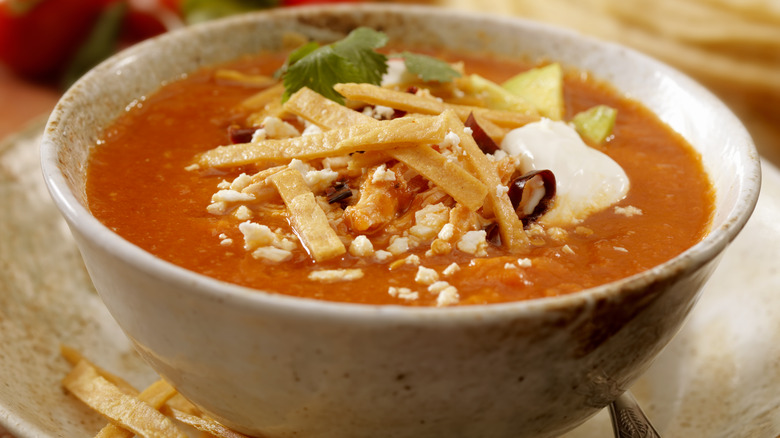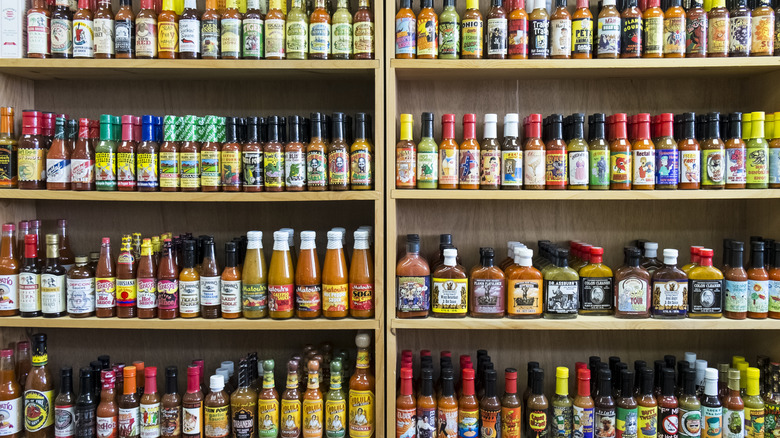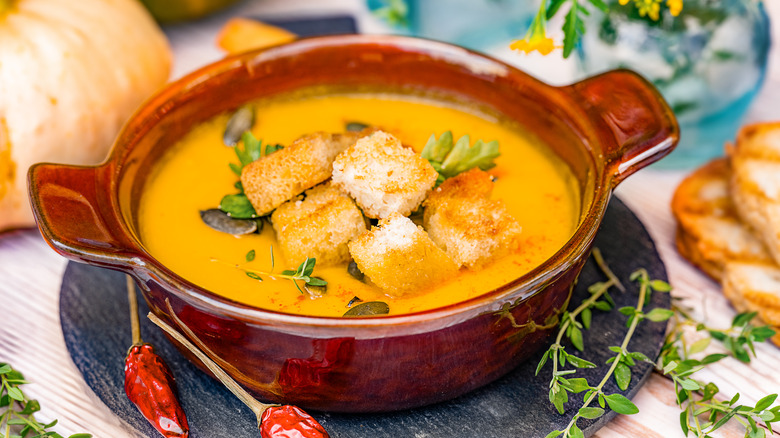The Secret Weapon To Spice Up Your Soup Is Already Sitting In Your Fridge
We may receive a commission on purchases made from links.
Upgrading soup with a couple of extra ingredients is one of the quickest and easiest ways to not only add flavor to a dish that can sometimes be quite bland, but it also allows you to customize store-bought soups, or change up the third night's helping of the big pot you made last weekend. Soups can be brightened with a squeeze of lemon or thickened with a bit of cornstarch or bread. Naturally, adding extra pepper, salt, or oregano will improve a basic chicken noodle, but one overlooked ingredient that can easily upgrade your soup may be staring at you from inside the pantry: hot sauce.
The thing with hot sauce is that there's a massive spectrum of flavors, heat, smoke, and sweet available. If you stick with only one brand, or haven't spent much time exploring hot sauce beyond your favorite fast food chain's version, you're missing out on the incredible complexities available. Which makes it an ideal condiment to round out soups, since soup is also so diverse, with endless variations from around the world.
Pairing soups and hot sauces
Hot sauce is an easy soup upgrade because you may add as much or as little as you want, either as an ingredient or as a garnish. It works well with store-bought, canned, or homemade soups. The trick is to get to know the different types of hot sauce and what they bring to the party.
The core hot sauces commonly found on store shelves and in restaurants, like Tabasco, Tapatio, or sriracha, tend to share a lot of the same ingredients: chili peppers, vinegar, salt, and sometimes garlic, along with other spices. They work nicely as a quick add to standard soups: chicken noodle, navy bean, and tortilla soup (of course). Meat-and-bean soups particularly benefit from these hot sauces since they are essentially watered-down chilis, and hot sauce is a secret ingredient you probably already add to your chili.
Of course, one of the primary factors that differentiate hot sauces is, well, heat. Peppers contain a molecule called capsaicin, and it's responsible for how hot a variety is. Measured in Scoville Heat Units (SHU), milder peppers like chipotle run about 10,000 to 20,000 Scoville Units. Habanero (Scotch bonnet) clocks in between 100,000 and 350,000 SHU, while Pepper X, currently the hottest in the world, comes in at something like 2.7 million. Needless to say, depending on your heat tolerance, just a dash or two of the very hot stuff will be plenty for a bowl of soup.
Get inventive with creative pairings
The fun comes when you start playing around with the wider portfolio of both hot sauces and soups. For example, if straight-up spicy isn't what you want, consider going smoky. Cholula Chipotle Hot Sauce captures the smoke-and-sweet nature of the dried peppers in a bottle. Korean gochujang, which is also delicious in breakfast burritos, is a red chile paste that carefully balances smoke, spice, and umami notes in various combinations. Both work wonderfully as additions to creamy roasted tomato soup, or a smoky potato bacon soup.
If you want something sweeter, there are a number of fruit-forward hot sauces that bring the heat, but contribute sweet and citrus notes as well. Weak Knees, from Brooklyn-based Bushwick Kitchen, specializes in combining sweet fruits and hot peppers. The brand's Crisp Apple Jalapeño imparts a pleasant bite, but adds plenty of green apple top notes, which work nicely in cold gazpacho or to add zing to Swedish fruit soup. Or toss the citrusy, sweet heat found in Arizona Gunslinger Habanero & Mango Pepper Sauce into a roasted butternut squash or Thai-inspired coconut and pumpkin soup.


